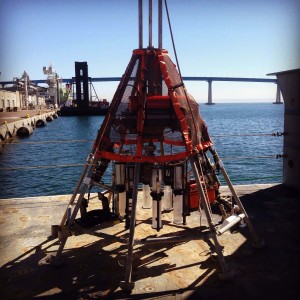My own research on this cruise involves coring to collecting seafloor sediments to study the foraminifera (protists with a hard shell, or “test,” that are commonly preserved in marine sediments) that live on the seafloor in low oxygen environments. Forams are pretty rad, and I will probably write another post about how rad they are, but this is not the place for that. Rather, I want to talk about the physical process of coring. We are using a multicorer (pictured) to collect sediment samples. Multicorers gently penetrate the upper portion of the seafloor in order to capture a well-preserved sediment-water interface. This allows micropaleontologists (me, in this case) to collect the foraminifera living there.
^Multicorer
This particular multicorer, which is owned and run by a coring group out of Oregon State (who provide coring support for all UNOLS cruises that need it) has been modified by the MISO imaging group from Woods Hole, who have installed a CTD oxygen sensor so that we can measure oxygen on the seafloor, and, more awesomely, a camera which takes still images every 10 seconds. This allows us to get images of the portion of the seafloor that we sample, and even choose to move our sample location if we don’t like it. Usually this process involves “hovering” over the seafloor, where we hold the multicorer about 5 m above the bottom and let it take pictures for a few minutes, before pulling it back up a few meters and the letting it land at around 15 m/minute. Obviously, it is pitch black on the seafloor, so the camera comes with two strobes to illuminate the scene.
Now, it’s important for you to understand how cool this is. Usually, when you’re coring, you have no idea what the seafloor looks like. You take a 4-inch diameter core, and that’s your only picture of what’s down there. Now, you can have a literal picture of what’s down there, and in this case many pictures. And it’s so cool. I mean, just look at this:
Note the differences between the two. The top is a submarine channel, where sediments flow down from the shelf into a basin. Because this is a higher energy environment it has larger grains (mostly sand) and the ripples that you can see in the image. The second is from the middle of San Nicolas Basin, at 1500 m water depth, in nice soft mud full of burrows and brittle stars and shrimp. You can see the whole benthic community, and have a real understanding of where your sample is coming from.
Also, for just a moment, put yourself in that crab’s shoes. You live on the bottom of the ocean, in pitch blackness. For your entire life, nothing has happened. Then one day, a strobe light comes down from above, and then this giant flashing contraption crashes down next to you, grabs some mud, and then disappears back up into the sky, still flashing as it goes.
Posted by Chris



